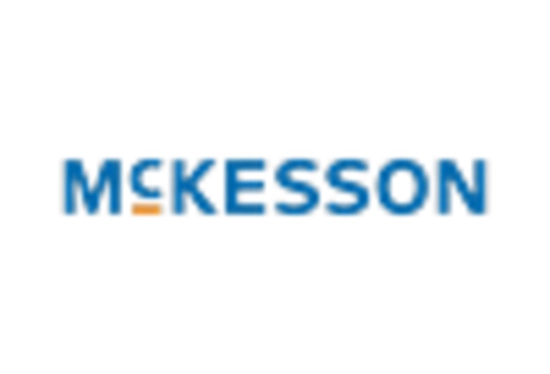The Medical Equipment Management Software Market is currently characterized by a dynamic competitive landscape, driven by technological advancements and an increasing emphasis on operational efficiency within healthcare systems. Key players such as GE Healthcare (US), Siemens Healthineers (DE), and Oracle Corporation (US) are strategically positioning themselves through innovation and partnerships. GE Healthcare (US) focuses on integrating artificial intelligence into its software solutions, enhancing predictive maintenance capabilities, which is crucial for optimizing equipment utilization. Siemens Healthineers (DE) emphasizes regional expansion, particularly in emerging markets, to capture a broader customer base, while Oracle Corporation (US) is leveraging its cloud infrastructure to offer scalable solutions that cater to diverse healthcare needs. Collectively, these strategies not only enhance their competitive edge but also contribute to a more integrated and efficient healthcare ecosystem.
In terms of business tactics, companies are increasingly localizing manufacturing and optimizing supply chains to respond swiftly to market demands. The competitive structure of the Medical Equipment Management Software Market appears moderately fragmented, with several players vying for market share. However, the influence of major companies is substantial, as they set industry standards and drive innovation. This competitive interplay fosters an environment where smaller firms may struggle to keep pace, yet it also encourages collaboration and partnerships that can lead to enhanced service offerings.
In August 2025, GE Healthcare (US) announced a strategic partnership with a leading AI firm to develop next-generation predictive analytics tools for medical equipment management. This collaboration is poised to enhance the efficiency of healthcare operations by enabling real-time monitoring and predictive maintenance, thereby reducing downtime and operational costs. Such initiatives reflect GE's commitment to innovation and its understanding of the critical role that advanced analytics play in modern healthcare.
Similarly, in September 2025, Siemens Healthineers (DE) launched a new software platform designed to streamline equipment management across multiple healthcare facilities. This platform integrates seamlessly with existing hospital systems, allowing for improved asset tracking and utilization reporting. The launch signifies Siemens' focus on enhancing interoperability and user experience, which are increasingly vital in a landscape where healthcare providers seek comprehensive solutions that can adapt to their specific needs.
In October 2025, Oracle Corporation (US) unveiled an upgraded version of its medical equipment management software, featuring enhanced cloud capabilities and improved data security measures. This upgrade is particularly significant as it addresses growing concerns regarding data privacy and compliance in the healthcare sector. By prioritizing security alongside functionality, Oracle positions itself as a leader in providing reliable and secure solutions that meet the evolving demands of healthcare organizations.
As of October 2025, the competitive trends within the Medical Equipment Management Software Market are increasingly defined by digitalization, sustainability, and the integration of artificial intelligence. Strategic alliances are becoming more prevalent, as companies recognize the value of collaboration in driving innovation and expanding market reach. Looking ahead, it is likely that competitive differentiation will shift from traditional price-based strategies to a focus on technological innovation, enhanced service delivery, and supply chain reliability. This evolution underscores the necessity for companies to adapt and innovate continuously in order to maintain their competitive positions in a rapidly changing market.

















Leave a Comment